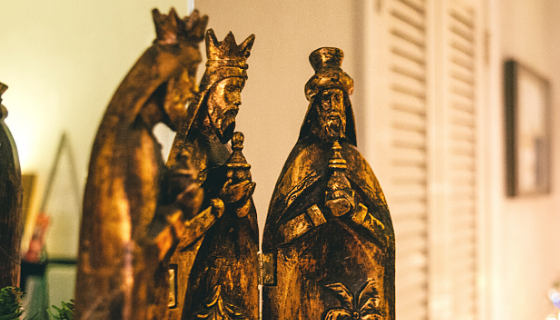The popular holiday of Three Kings (“Epiphany”) is considered the oldest Christian holiday. As is usually the case with so-called Christian holidays, the truth is a bit tangled. The term “Epiphany” in ancient literature means revelation, of course, but the epiphany was a pagan festival of the solar deity Aion, born of the virgin Cora, which was celebrated in Alexandria on the night of January 5-6. It was associated with night vigils and chanting. In the morning, usually with the crowing of a rooster, one ascended solemnly to a dark cave and carried the little Aion from there:
Christians began to celebrate this holiday on the model of the pagan one, replacing Aion with Christ. There is nothing strange about this, just as Christmas was copied from a feast on the part of Mithras, so too Holy Night, Whitsun, Midsummer’s Night, or the Day of the Dead, are also copied from pagan rituals.
But that’s not all. The three kings are still missing. Only in Matthew’s gospel is there a mention of them, but not rulers, but magicians /”magoi” from the Greek/.
(It should be remembered, however, that in the days of Babylonia or Medo-Persia, the group of magicians included high-ranking dignitaries who formed the government of the time and had a rank similar to that of ministers today. The prophet Daniel, who was always faithful to the One God Yahuah, and never engaged in any magic or sorcery, formally belonged to this group as well) – Our Footnote
It is also unknown how many of these magi (sages) there were, only Origen put forward the conjecture that there may have been three.
The legend of the three kings who came to bow down to the Messiah was invented by the Carmelite John of Hildesheim in the 14th century. He is the one who turned the sorcerers into kings and even gave them names: Casper, Melchior and Balthazar. Remarkably, the legend received an enthusiastic reception and the “History of the Three Kings” (Historia Trium Regium) was spread. Ecclesiastical dignitaries in particular were pleased; after all, three rulers (not sorcerers!) bowing to the Messiah is a much-talked-about symbol that can be invoked in theological considerations and intimidate secular authorities.
St. John of Hildesheim had it easy because as early as 1162 Emperor Frederick I Barbarossa discovered the somewhat forgotten relics of the three sorcerers in Milan (St. Helena, who found everything, found them, of course:) The alleged remains of the saints were placed in a massive reliquary and even a gigantic cathedral in Cologne was built especially for them. Thanks to this, the city began to quickly earn money from pilgrims.
In 1981, Professor David de Jonghe of Brussels subjected the alleged remains to research and found them to be very old, but not old enough – namely, they date from the 3rd-4th centuries.
During the conquests of the Portuguese in America, another king appeared in the iconography, this time Indian (!), but he would not be accepted 🙂
// Many thanks to the website administrator www.salon24.pl for gathering the information
